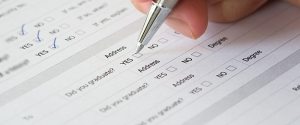Marketing surveys are part of survey design services and are considered as the primary phase in helping business entities to improve and expand their marketing strategy, the product or service they offer, or pricing schemes (sentence restructured to accommodate the keyword in the first 150 words. Does it make sense?). Through marketing surveys, businesses will have a good understanding of what the customers want or need.

Business-to-Business (B2B) and Business-to-Consumer (B2C) marketers often employ marketing surveys in order to measure consumers’ interests regarding the company’s new line of products or new service offerings, collect market data on sales trends and competitors, or create a list of prospective customers. Usually, these type of survey design services is quantitative in nature meaning large sample sizes are involved (restructured the sentence to include the keyword) .
Typical B2B and B2C market research services include survey design services, survey administration, survey reporting, mail surveys, telephone surveys, and statistical reporting, which can undeniably help marketers in making cognizant business judgments.
Survey Design Services
Designing surveys often entails( entail) determining the suitable sample size, fitting survey method to be utilized, ideal survey length, and appropriate questionnaire format and content. Consultation services and suggestions related to market research and census matching are also being offered and are encompassed in survey design services.
Sample Size
The survey sample size is described as the number of respondents from the target population. What is the perfect sample size? How many respondents should be involved? Having a large sample size will give you conclusive data; however, superfluous responses are costly.
In order to determine the perfect sample size, there are various aspects that need to be taken into account. First is the analytical plan. Will you use statistical methods? If so, ensure that you’d meet the required number of responses needed to, let’s say differentiate two similar brands. Also, think on how you are going to utilize the collected data. Next is population variability. How diversified is your target population? Think about the demographics. Another factor is the confidence level. It is characterized as the tolerable level of risk, typically in percentage and is inversely proportional relative to accuracy. The higher the confidence interval, the lower is its precision. The usual confidence levels are at 90%, 95%, and 99%. The last aspect is the margin of error, which illustrates the level of precision. In here, the smaller the margin of error, the higher is the survey’s precision.
Always remember that a sample size that is too low will generate a high margin of error and a low level of confidence, hence a less reliable data. On the other hand, a sample size that is too high is quite pricey and trivial.
Survey Method
B2B and B2C marketers rely on market surveys in acquiring information about their consumers, competitors, and how their brand is perceived. There are various survey methods that marketers can use, which are classified as quantitative or qualitative: (replaced the full stop with the colon )
- Qualitative Research – This type of research consider (considers) the consumer’s views and emotions relative to the entity’s product or service. The purpose of a qualitative research is to fully understand how the customer’s think and get to the bottom of their thoughts to unravel what they feel about the brand. Under this kind of research are the observational method, depth interviews, focus groups, and online forums.
- Quantitative Research- On the contrary, a quantitative research is established on evidence and statistical information. Examples are telephone surveys, personal interviews, online surveys, and hybrid survey methods.
Survey Length
According to studies, longer surveys usually lead to bad data. Not only lengthy surveys are pricey, but also the quality of response data declines as the survey time progresses. But how protracted should your survey be? There are scientific formulae in measuring the “ideal” survey length.
Formula 1: SL = (W/5 + Q*5 + (D-Q)*2 + T*15)/60,
where SL = survey length
W = word count
Q = number of questions
D = total number of decisions respondents have to make (single choice = 1 decision; multi-choice = 0.5 decision; grids = 1 decision per row)
Formula 2: SL = (W/5 + R*1.8)/60,
where SL = survey length
R = total number of row options
Formula 3: SL = W/150
where SL = survey length
W = word count
There are also recommended survey lengths for every type of surveys.
➔ Online surveys = 20 minutes max
➔ Telephone surveys = 20 minutes max
➔ Social media surveys = 10 minutes max
➔ Mobile surveys = 5 minutes max
If you want to take into consideration the ideal survey length when creating surveys, identify the significant questions, establish the survey’s goals and objectives, segment your survey, and think about the respondent’s’ time.
Survey Format and Content
It is a must that surveys are structured in a way that the essential features that will make the survey germane and appropriate to the sample size are included. With this, response rates will be maximized while errors will be reduced. The content of the surveys must be able to bring out the coveted response. Questionnaires should be clear, simple, and explicit.
In creating survey questions, there are five formats that can be employed: open-ended, modified open-ended, closed-ended with ordered response choices, closed-ended with unordered response choices, and partially closed-ended. These format are applicable depending on its purpose, the behavior to be gauged, or the attitude to be measured or evaluated. Generally, open-ended are the most complex while closed-ended (ordered and unordered) are preferred since responses are not that difficult to input for data processing.
